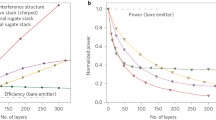Abstract
Spectral control is an enabling technology for greater than 10% efficient thermophotovoltaic (TPV) energy conversion [1-3]. Without control of the spectral distribution of photons reaching a TPV cell, the efficiency of a TPV energy conversion system suffers dramatically. Spectral control is the selection, design, and development of materials and structures used in TPV energy conversion systems to maximize the net flux of convertible (above band gap) photons, minimize the net flux of unconvertible (below band gap) photons, and recuperate (or reflect) any net flux of unconvertible (below band gap) photons that reach the TPV cell back to the radiating surface. Front surface, tandem filters consisting of an edge pass filter (short pass) in series with a highly doped, epitaxially grown layer have achieved the highest energy weighted spectral efficiency to date.
The performance, however, of these tandem filters is limited by at least two fundamental physical phenomena: the variation in performance with the incident angle of the photons and absorption in the filter materials. Three dimensional (3D), photonic crystal structures offer a potential solution to these fundamental limitations of tandem filters as well as the potential of spectral control for the radiating surfaces of TPV energy conversion system. First, 3D photonic crystal structures, in theory, perform equally for all incident angles. Second, the fabrication techniques for 3D photonic crystal structures may allow the use of materials (such as crystalline Si) with less absorption in the spectral range of interest (1-15μm) than the materials currently used in tandem filters. The fabrication techniques for 3D photonic crystal structures may also allow the use of high temperature (1000°C) materials for use as radiating surface spectral control. If so, 3D photonic crystal structures may be used to mitigate several of the inefficiencies associated with TPV systems.
The conclusion of this assessment is that 3D, photonic crystal structures can, in theory, provide near perfect TPV spectral control. If so, these structures may allow a 20% improvement over the performance achieved by tandem filters. Realizing this potential for TPV spectral control, however, will likely require significant development. At least two major challenges exist:
-
Design techniques will likely need to be developed that will allow the analysis and design of 3D photonic crystal structures.
-
Fabrication techniques will need to be developed for these structures that provide sufficient fidelity to a design to achieve the required performance and can be scaled to provide the area required for a given TPV application.
Similar content being viewed by others
References
Baldasaro, P.F., et al., Thermodynamic Analysis of Thermophotovoltaic Efficiency and Power Density Tradeoffs. Journal of Applied Physics, 2001. 89: p. 3319–3327.
Fourspring, P.M., et al. Thermophotovoltaic Spectral Control. in 6th International Conference on the Thermophotovoltaic Generation of Electricity (TPV6). 2004. Frieburg, Germany: AIP.
DePoy, D.M., et al. Thermophotovoltaic Spectral Control. in International Energy Conversion Engineering Conference. 2004. Providence, RI, USA: AIAA.
Joannopoulos, J.D., R.D. Meade, and J.N. Winn, Photonic Crystals: Molding the Flow of Light. 1995.
Sakoda, K., Optical Properties of Photonic Crystals. 2001: Springer.
Ribbing, C.-G., Photonic Structures as Interference Devices, in Optical Interference Coatings, N. Kaiser and H.K. Pulker, Editors. 2003.
Joannopoulos, J.D., Private Communication. 2004.
Johnson, S.G. and J.D. Joannopoulos, Three-dimensionally periodic dielectric layered structure with omnidirectional photonic band gap. Applied Physics Letters, 2000. 77(3490).
Qi, M., et al., A Three-Dimensional Optical Photonic Crystal with Designed Point Defects. Nature, 2004. 429.
Johnson, S.G. and J.D. Joannopoulos, Photonic Crystals: The Road from Theory to Practice. 2002: Klurwer Academic.
Author information
Authors and Affiliations
Rights and permissions
About this article
Cite this article
Fourspring, P.M. Photonic Crystal Structures as Spectral Control for Thermophotovoltaic Energy Conversion. MRS Online Proceedings Library 1162, 202 (2009). https://doi.org/10.1557/PROC-1162-J02-02
Received:
Accepted:
Published:
DOI: https://doi.org/10.1557/PROC-1162-J02-02




